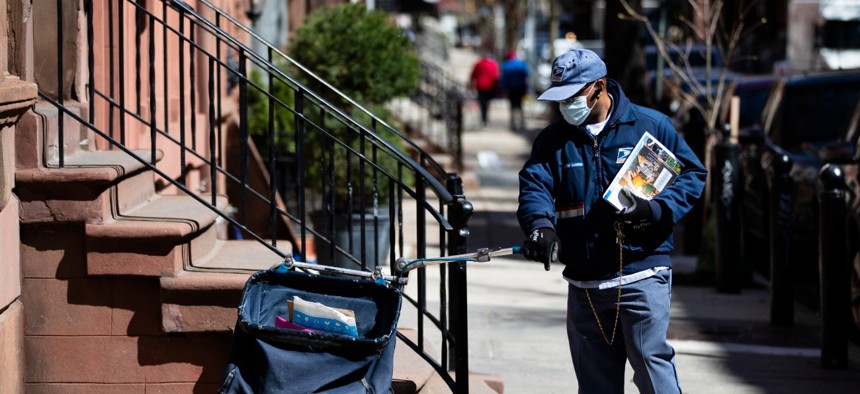
A postal worker delivers mail in Philadelphia on April 2. Matt Rourke/AP
USPS Sees Revenue Increase in Second Quarter, Warns Worst Is Yet to Come
Census mailing and package increases helped the Postal Service, but the agency says the bottom will soon fall out.
The Postal Service increased its revenue in the second quarter of fiscal 2020 by 2% compared to the same period the year before, despite a looming crisis due the novel coronavirus pandemic and a net loss of $4.5 billion.
USPS’ $17.8 billion in revenue from Jan. 1 through March 31 was aided by two factors: the Census Bureau mailing out forms to every household in the country for its decennial count and a 7% increase in package revenue, or a $386 million bump. Despite the Census mail surge, first-class mail volume—the Postal Service’s most profitable offering—declined slightly in the quarter compared to the same period last year.
The Postal Service’s overall loss in the quarter more than doubled, but that was driven largely by fluctuations in interest rates on workers’ compensation liability. USPS’ controllable loss—which factors out any expenses outside the control of management—was $792 million, a slight improvement from the previous year.
Postal management cautioned the major effects of the current global health and economic crises are largely not reflected in last quarter’s numbers. USPS has requested $75 billion in financial liquidity to offset the losses it expects due to a downturn in mail use and to place the agency on firmer footing after more than a decade of declining mail volume.
"Although the pandemic did not have significant impact on our financial condition in our second quarter, we anticipate that our business will suffer potentially dire consequences for the remainder of the year, and we are already feeling those impacts during the last half of March,” Postmaster General Megan Brennan said.
More than 2,000 postal employees have tested positive for COVID-19 and 54 have died from related symptoms. Brennan said the pandemic has demonstrated America “needs the Postal Service more than ever” and that it is “imperative” Congress takes action to shore up the agency’s finances.
USPS noted package delivery is more labor intensive and less profitable than regular mail and increases there will not offset losses due to the coronavirus outbreak. The agency’s operating expenses increased by nearly $3 billion in the quarter, a jump of 14%. Controllable expenses increased by $328 million, or 2%.
“While we continue to conserve capital and reduce expenses in areas where volumes are declining, our ability to continue to serve the nation will require substantial funding from the federal government or other sources,” said Joe Corbett, the USPS chief financial officer.
While postal management said earlier this year it would likely run out of cash by the end of September, the agency said in a financial document accompanying its quarterly data that by accessing a $10 billion loan from Treasury and prioritizing some payments over others "it expects that it will have sufficient liquidity to continue operating through at least May 2021."
The Postal Service will have new leadership next month, when Louis DeJoy replaces Brennan as postmaster general. Some of the agency’s largest customers and its labor groups have expressed concern that DeJoy represents a politicized pick aimed at appeasing President Trump’s desire to avoid financial support for USPS in favor of rate increases.
Fredric Rolando, president of the National Association of Letter Carriers, noted USPS was showing a 5% revenue increase in February before the impact of the economic downturn began to hit in March.
“That is why temporary federal funding is urgently needed, so the USPS can weather the storm and continue to provide Americans and their businesses with the industrial world’s most-affordable delivery network,” Rolando said. “Just like the airlines and hotels and small businesses, the USPS, which also operates on earned revenue, needs assistance in these unprecedented times.”
Two recent polls show American overwhelmingly support financial assistance for the Postal Service.
NEXT STORY: Viewpoint: Why Michael Flynn Is Walking Free







